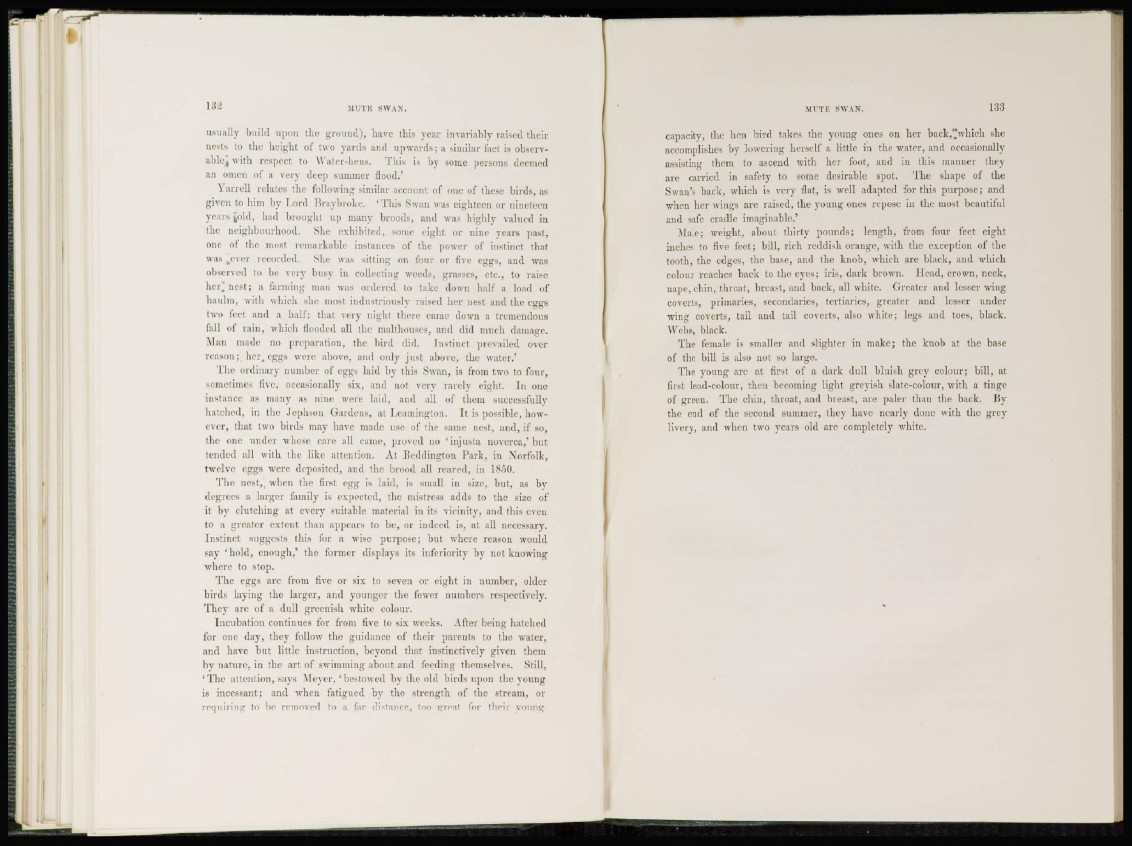
usually build upon the ground), have this year invariably raised their
nests to the height of two yards and upwards; a similar fact is observablej
with respect to Water-hens. This is by some persons deemed
an omen of a very deep summer flood.'
Varrell relates the following similar account of one of these birds, as
given to him by Lord Braybrohe, 'This Swan was eighteen or nineteen
years [old, had brought up many broods, and was highly valued in
the neighbourhood. She exhibited, some eight or nine years past,
one of the most remarkable instances of the power of instinct that
was %ever recorded. She was sitting on four or five eggs, and was
observed to be very busy in collecting weeds, grasses, etc., to raise
h e r ^ n e s t ; a farming man was ordered to take down half a load of
haulm, with which she most industriously raised her nest and the eggs
two feet and a hall': that very night there came down a tremendous
fall of rain, which flooded all the malthouscs, and did much damage.
Man made no preparation, the bird did. Instinct prevailed over
reason; her, eggs were above, and only just above, the water.'
The ordinary number of eggs laid by this Swan, is from two to four,
somel ¡mes live, occasionally six, and not very rarely eight. In one
instance as many as nine were laid, and all of them successfully
hatched, in the Jephson Gardens, at Leamington. It is possible, however,
that two birds may have made use of the same nest, and, if so,
the one under whose care all came, proved no 'injusta noverca/but
tended all with the like attention. At Bcddington Bark, in Norfolk,
twelve eggs were deposited, and the brood all reared, in 1850.
The nest, when the first egg is laid, is small in size, but, as by
degrees a larger family is expected, the mistress adds to the size of
it by clutching at every suitable material in its vicinity, and this even
to a greater extent than appears to be, or indeed is, at all necessary.
Instinct suggests this for a wise purpose; but where reason would
say ' hold, enough,5 the former displays its inferiority by not knowing
where to stop.
The eggs arc from five or six to seven or eight in number, older
birds laying the larger, and younger the fewer numbers respectively.
They are of a dull greenish white colour.
Incubation continues for from five to six weeks. After being hatched
for one day, they follow the guidance of their parents to the water,
and have but little instruction, beyond that instinctively given them
by nature, in the art of swimming about and feeding themselves. Still,
' T h e attention, says Meyer, 'bestowed by the old birds upon the young
is incessant; and when fatigued by the strength of the stream, or
requiring to be removed to a far distance, ton [jrnnt for their young
capacity, the hen bird takes the young ones on her back/'which she
accomplishes by lowering herself a little in the water, and occasionally
assistiug them to ascend with her foot, and in this manner they
are carried in safety to some desirable spot. The shape of the
Swan's back, which is very flat, is well adapted for this purpose; and
when her wings are raised, the young ones repose in the most beautiful
and safe cradle imaginable.'
Male; weight, about thirty pounds; length, from four feet eight
inches to five feet; bill, rich reddish orange, with the exception of the
tooth, the edges, the base, and the knob, which are black, and which
colour reaches back to the eyes; iris, dark brown. Head, crown, neck,
nape, chin, throat, breast, and back, all white. Greater and lesser wing
coverts, primaries, secondaries, tertiarics, greater and lesser under
wing coverts, tail and tail coverts, also white; legs and toes, black.
Webs, black.
The female is smaller and slighter in make; the knob at the base
of the bill is also not so large.
The young arc at first of a dark dull bluish grey colour; bill, at
first lead-colour, then becoming light greyish slate-colour, with a tinge
of green. The chin, throat, and breast, are paler than the back. By
the end of the second summer, they have nearly done with the grey
livery, and wdien two years old are completely white.